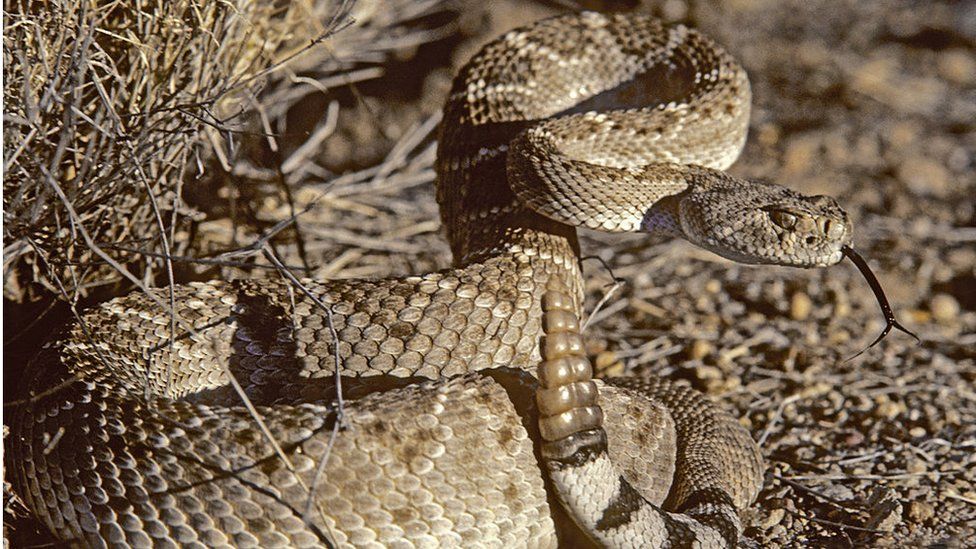What Makes A Rattlesnake Rattle
Nature: Rattlesnakes' sound 'play a trick on' fools human ears
By Matt McGrath
Environment contributor
 Prototype source, Getty Images
Prototype source, Getty Images
Rattlesnakes are the source of the majority of bites inflicted on humans in the US every twelvemonth
Rattlesnakes have evolved a clever method of disarming humans that danger is closer than they think, say scientists.
The sounds of their shaking tail get louder as a person approaches, but so suddenly switches to a much higher frequency.
In tests, the rapid alter in sound made participants believe the snake was much nearer than it was in reality.
The researchers say the trait evolved to help snakes avoid being trampled on.
The sibilant sound of the rattlesnake's tail has long been a motion-picture show cliché.
The tell tale rattle is made by the rapid shaking together of hard rings of keratin at the tip of the reptiles' tails.
Keratin is same protein that makes up our fingernails and hair.
Image source, Tobias Kohl
The hard keratin segments make up the rattle on the snake's tail
The central to the dissonance is the snake's ability to milkshake its tail muscles upwardly to xc times a second.
This vigorous shaking is used to warn other animals and humans of their presence.
Despite this, rattlesnakes are still responsible for the majority of the 8,000 or then bites inflicted on people in the US every year.
Researchers take known for decades that the rattling can change in frequency but there'south been little research about the significance of the shift in sound.
In this study, scientists experimented by moving a human-like torso closer to a western diamondback rattlesnake and recording the response.
As the object got closer to the snake, the rattles increased in frequency up to around 40Hz. This was followed by a sudden jump in sound into a college frequency range betwixt 60-100Hz.
To figure out what the sudden change meant, the researchers carried out further piece of work with human participants and a virtual snake.
The increasing rattling rate was perceived past participants as increasing loudness equally they moved closer.
Prototype source, Getty Images
Hunters in Texas with a captured western diamondback rattlesnake
The scientists found that when the sudden modify in frequency occurred at a distance of 4 metres, the people in the exam believed information technology was far closer, around one metre away.
The authors believe the switch in sound is not just a uncomplicated warning, but an intricate, interspecies advice bespeak.
"The sudden switch to the high-frequency manner acts equally a smart signal fooling the listener almost its actual distance to the sound source," says senior author Boris Chagnaud from Karl-Franzens-University in Graz, Austria.
"The misinterpretation of altitude by the listener creates a distance safe margin."
The authors believe that the snakes behaviour takes advantage of the human auditory organization, which has evolved to interpret an increase in loudness every bit something that is moving faster and getting closer
"Evolution is a random process, and what we might interpret from today'southward perspective equally elegant blueprint is in fact the outcome of thousands of trials of snakes encountering big mammals," said Dr Chagnaud.
"The snake rattling co-evolved with mammalian auditory perception by trial and mistake, leaving those snakes that were best able to avoid existence stepped on."
The study has been published in the journal Current Biology.
Follow Matt on Twitter @mattmcgrathbbc.
Source: https://www.bbc.com/news/science-environment-58270599#:~:text=The%20tell%20tale%20rattle%20is,up%20our%20fingernails%20and%20hair.&text=The%20key%20to%20the%20noise,to%2090%20times%20a%20second.
Posted by: herbertthead1935.blogspot.com

0 Response to "What Makes A Rattlesnake Rattle"
Post a Comment